The Order of the Golden Fleece is an order of chivalry that was founded by Philip III, the Duke of Burgundy, on the occasion of his marriage to Isabella of Portugal in the 15 th century. Through the centuries the order passed from the House of Burgundy to the House of Habsburg, split into two branches as a consequence of the Spanish War of Succession in the early 18 th century, and survives even to this day. Some of the more famous members of the order include the French emperor Napoleon Bonaparte, Emperor Meiji of Japan, and Queen Elizabeth II.
The Founding of the Order
The Order of the Golden Fleece was founded in Bruges, Flanders, on the 10 th of January 1430 by Philip III ‘the Good’, the Duke of Burgundy, to commemorate his marriage to Isabella of Portugal. The creation of the chivalric order was announced during the wedding celebrations, and its first ceremonial meeting took place in the following year. Incidentally, Isabella’s maternal great grandfather was Edward III of England, who established the Order of the Garter in 1348.
The first ceremonial meeting of the Order of the Golden Fleece was held in Lille on the 30 th of November, 1431. This day is significant, as it is the feast day of Saint Andrew, the patron saint of the House of Burgundy. The new order was therefore dedicated to Saint Andrew, as well as to the Virgin Mary.
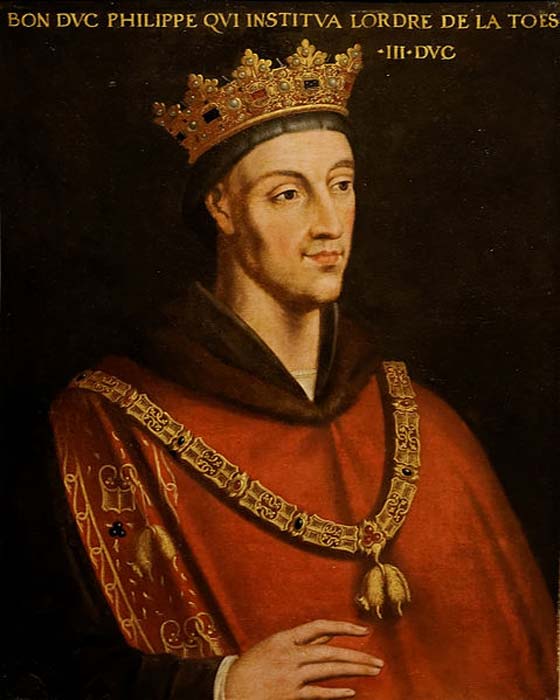
Philip III, Duke of Burgundy wearing the chain of the Order of the Golden Fleece (Musée des Beaux-Arts de Dijon / CC BY-SA 4.0 )
During the meeting, the regulations of the order were acknowledged, and the first 24 knights were nominated by Philip. Naturally, the first grand master of the order was the duke himself. In addition to the grand master, the order had four other officers – a treasurer, a master-at-arms, a chancellor, and a registrar. Whilst the order started with 24 knights, their number was later increased, though still limited.
Apart from these members, only high-ranking nobles were eligible to become a knight of this order. Thus, Philip sought to use the Order of the Golden Fleece to strengthen his ties with the nobility, thereby increasing his own power and prestige.
The creation of the Order of the Golden Fleece was also aimed at upholding a chivalric standard amongst its members. Moreover, there was a religious dimension to the order, as its knights were to promote the glory of God, and to defend the Christian faith.
It is rather intriguing to consider that whilst Christianity and chivalry are supposed to be at the core of the Order of the Golden Fleece, its name, ironically, appears to refer to the story of Jason and the Golden Fleece , a pagan myth centered around a hero with questionable morals. There are however several alternative, though less convincing, explanations for the order’s name. One of these, for instance, asserts that the order’s name was inspired by Isabella’s red hair, whereas another claims that it was named after the blonde hair of Mary van Crombrugghe, the most famous of Philip’s 24 mistresses.
The Myth of Jason and the Golden Fleece
Jason and the Golden Fleece is an ancient Greek myth, the most famous version of which comes from Apollonius of Rhodes’s Argonautica. The main protagonist of the tale is Jason, the son of Aeson, the King of Iolcus, in Thessaly. When Jason was still a baby, he was sent to the centaur Chiron to be raised, returning to Iolcus in adulthood.
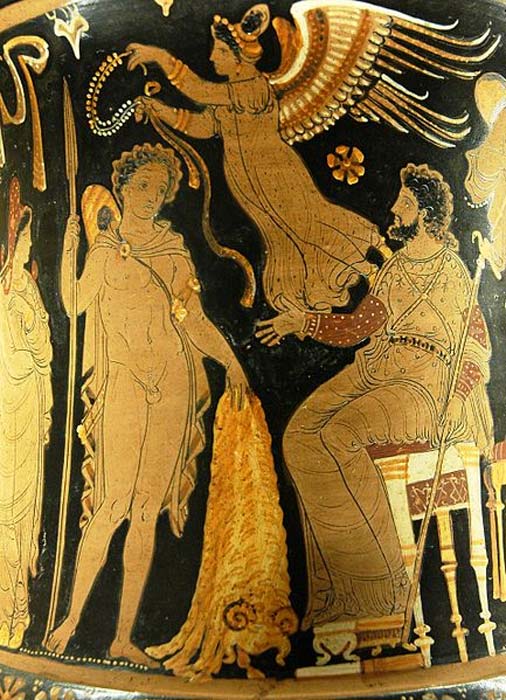
Jason, Pelias and the Golden Fleece ( Public Domain )
By that time, however, the throne had been usurped by Pelias, Aeson’s half-brother. As Pelias was fearful that he would lose the throne, he consulted an oracle, who warned him that a man wearing one sandal would cause his downfall.
According to one version of the myth, Jason, whilst on his way back to Iolcus, met an old woman, and carried her across the Anauros River. This old woman was supposed to have been the goddess Hera in disguise. In any case, Jason lost a sandal whilst crossing the river. Therefore, when he arrived in Iolcus, Pelias recognized him as the man with one sandal foretold by the oracle, and became alarmed.
The Argonauts and the Golden Fleece
One version of the myth states that Pelias agreed to surrender the kingdom to Jason, but asked the hero to bring him the Golden Fleece, so as to lift a curse from his family. In another version of the myth, Pelias asked Jason what he would do if he met the man who would cause his downfall. Jason, unaware that it was Pelias who was speaking to him, replied that he would send him to retrieve the Golden Fleece. In either case, Pelias decided to send Jason on this impossible mission, hoping that he would perish in the process.
The Golden Fleece belonged to Aeëtes, the King of Colchis, and was hung on an oak in a grove sacred to Ares. Although the fleece was guarded by a dragon that never sleeps, the myth would demonstrate that Aeëtes was an even greater obstacle to Jason’s quest than this beast. In any event, Jason assembled a group of heroes to aid him on his quest.
Jason’s companions became known as the Argonauts, named after their ship, Argo, which in turn was named after its builder, Argus. The number and identity of the Argonauts varies from one source to another, though some of the more renowned include Heracles, Orpheus, the Gemini twins Castor and Pollux, and Asclepius. Jason and the Argonauts had numerous adventures before arriving at their destination.

Jason building the Argo (British Museum / CC BY 2.5 )
After his arrival in Colchis, Jason had an audience with the king, and requested the Golden Fleece from Aeëtes. Although the king promised to give the priceless object to the hero, he was actually not keen at all to do so. Therefore, Aeëtes set two impossible tasks for Jason, and would only hand him the Golden Fleece if he could accomplish them.
The first of these was to yoke the Khalkotauroi, and to plough a field with them. The Khalkotauroi, known also as the Colchis Bulls, were a pair of huge bulls with bronze hooves, and bronze mouths. Through the latter, the bulls breathed fire, thus making it impossible to yoke them. The second task was to sow in the field ploughed by the bulls the teeth of the dragon that guarded the Golden Fleece. Ferocious warriors would sprout from the teeth once they were sown, and Jason had to defeat them.
The Witch Medea
These tasks were extremely difficult, if not outright impossible, for Jason and his Argonauts to accomplish. Jason, however, was favored by the goddess Hera, who helped him by making Medea, the daughter of Aeëtes, fall in love with the hero.
Medea was a sorceress, and a high priestess of Hecate, so she knew how to accomplish the tasks set by her father. She agreed to help Jason, on the condition that he marry her once he obtained the Golden Fleece.
Jason agreed to Medea’s condition, and was given a magic salve that would protect him from the Khalkotauroi’s fire. For the second task, Medea told Jason to throw a stone amongst the warriors once they sprouted. This would throw them into confusion, and cause them to fight one other.
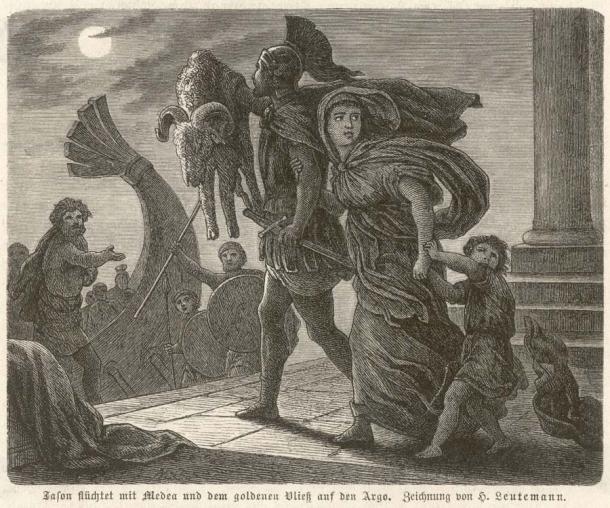
Jason flees Colchis with Medea and the Fleece ( Archivist / Adobe Stock)
Jason followed Medea’s advice, and accomplished the tasks at hand. Aeëtes, however, still refused to hand over the Golden Fleece, and plotted to kill Jason. Medea, however, discovered her father’s plot, and led Jason to the sacred grove, where he retrieved the fleece. Jason, the Argonauts, and Medea then fled Colchis.
The myth, however, does not end with Jason and Medea living happily ever after. Instead, Jason eventually deserted Medea, and ended his life as a lonely man.
The Golden Fleece in Philip’s Burgundy
The use of such a pagan myth involving an arguably less-than-chivalrous protagonist would no doubt be at odds with the core values of Philips’s Order of the Golden Fleece. Yet, an ingenious solution was concocted, allegedly by the Bishop of Nevers, to square this circle. The bishop proclaimed that the Golden Fleece was in fact was fleece of Gideon, an Israelite leader mentioned in the Old Testament’s Book of Judges. Thus, the order was given a Christian story to lay its foundations on.
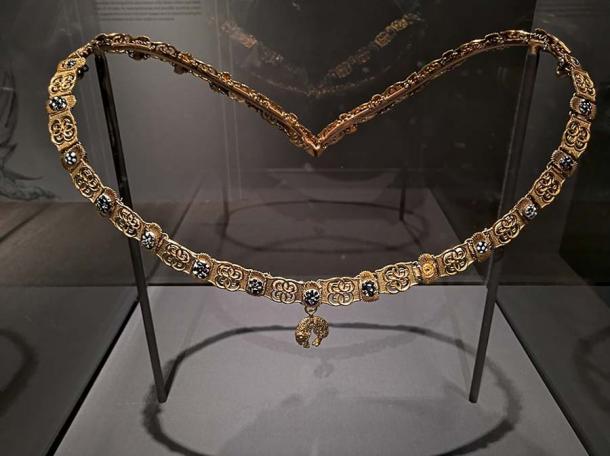
The gold chain and ram’s fleece (Wulfstan / CC BY-SA 4.0 )
In accordance with its name, the symbol of the order is a ram’s fleece (with its head and feet), which is suspended from a gold neck chain by a ring. Apart from this neck chain, the pomp and grandeur of the order is also reflected in the sumptuous red vestments worn by its members. These can be seen in paintings of the order, as well as in portraits of its members.
Moreover, some of these neck chains and vestments have been preserved by museums in Europe. A 15 th century neck chain, for instance, is kept in the Imperial Treasury, Vienna, along with other treasures of the Austrian branch of the order.
The Order after Philip
In 1477, Philip’s son and successor, Charles the Bold, died, which brought an end to the male line of the House of Burgundy. Charles had only one child, Mary of Burgundy. Although she continued to rule Burgundy, she lost much of her lands to the French. In order to counter further French aggression, Mary married the future Holy Roman Emperor Maximilian I , who was a member of the House of Habsburg. Through her marriage to Maximilian, the Order of the Golden Fleece passed into the House of Habsburg.
The House of Habsburg reached its zenith during the reign of Charles V, Maximilian’s grandson. During Charles’ reign, the Habsburgs were in control of Spain and its overseas empire, the Netherlands, parts of Italy, Austria, and Germany. Towards the end of his life, Charles gradually abdicated from his various thrones, and the domains of the Habsburgs were divided between a Spanish branch of the house, and an Austrian one. Since the former lands of Burgundy went to the Spanish Habsburgs, so too did the Order of the Golden Fleece.

Holy Roman Emperor Charles V wearing the chain of the Order of the Golden Fleece (Ann Longmore-Etheridge / Public Domain )
In 1700, Charles II, the last Habsburg ruler of Spain, died without an heir. Charles’s death triggered the War of the Spanish Succession in the following year. When the war ended in 1714, Spain was under the rule of a new dynasty, the House of Borbón-Anjou (a branch of the House of Bourbon) and the Spanish Habsburgs went extinct in Spain.
The Austrian line, however, continued for several more decades. The head of the Austrian Habsburgs, Charles VI, established a second, Austrian branch of the Order of the Golden Fleece.
Although both the Spanish and Austrian branches of the order co-existed peacefully, and continued to grant the Golden Fleece over the following centuries, they developed in quite different directions. The clearest distinction between the two branches is perhaps the retention of the order’s original spiritual character by the Austrian branch.
With the one exception of the Protestant George IV, who ruled Britain from 1820 to 1830, the Austrian order is reserved exclusively for Roman Catholic royals and nobles. On the other hand, the Spanish order became an order of merit, with adherence to Catholicism no longer a requirement for admittance.
Another distinction between the two orders emerged following the collapse of the House of Habsburg-Lorraine, the rulers of the Austro-Hungarian Empire, at the end of the WWI. As the Austrian Habsburgs were no longer members of a royal family, the Golden Fleece is granted by the head of the house, the current incumbent being Karl von Habsburg. On the other hand, the House of Borbón-Anjou is the reigning royal house of Spain, and therefore the Golden Fleece is granted by the King of Spain.
The Order Today
The Order of the Golden Fleece survives to this day, and is considered one of the most prestigious European orders of chivalry. Some living members of the Order of the Golden Fleece (Spanish branch) include Queen Elizabeth II of the United Kingdom, Emperor Emeritus Akihito of Japan, and Constantine II, the last King of Greece.
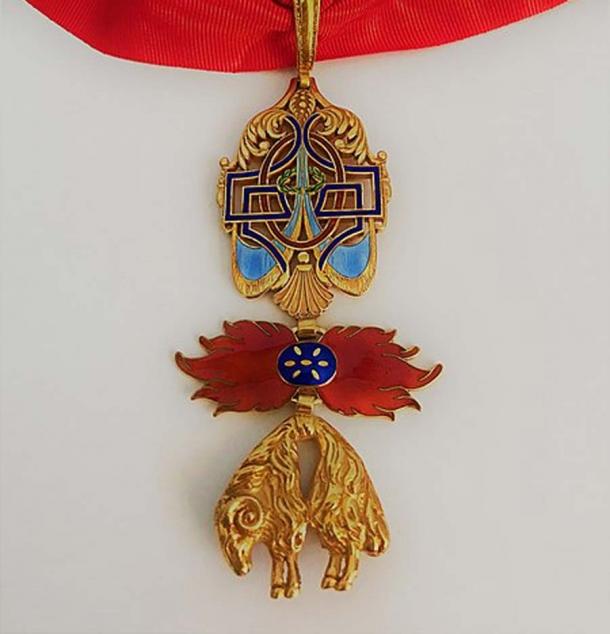
The Order of the Golden Fleece today (Presidentfranciscop / CC BY-SA 4.0 )
Although the Austrian branch of the order has more members, it is more exclusive, its knights being noblemen and princes of mostly German or Austrian origin. The branches are not mutually exclusive either. Indeed Albert II, the former King of Belgium, is a living member of both the Spanish and Austrian branches of the order.
Top image: Medea and the Golden Fleece. Source: roibu / Adobe Stock
By Wu Mingren
Related posts:
Views: 1
 RSS Feed
RSS Feed















 May 14th, 2021
May 14th, 2021  Awake Goy
Awake Goy  Posted in
Posted in  Tags:
Tags: 
















